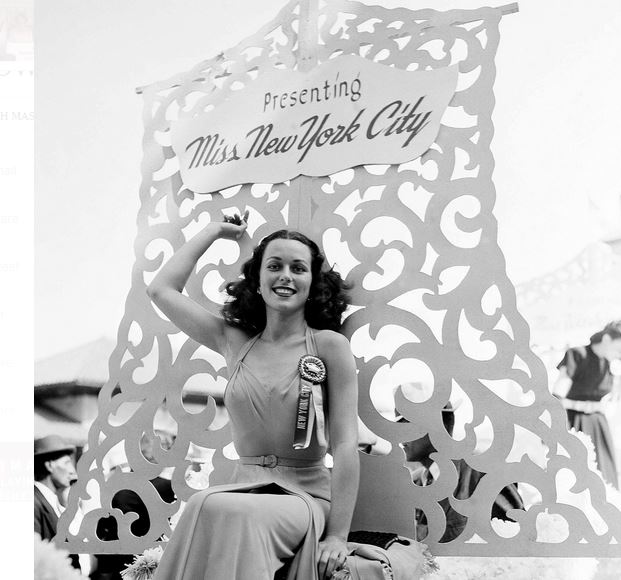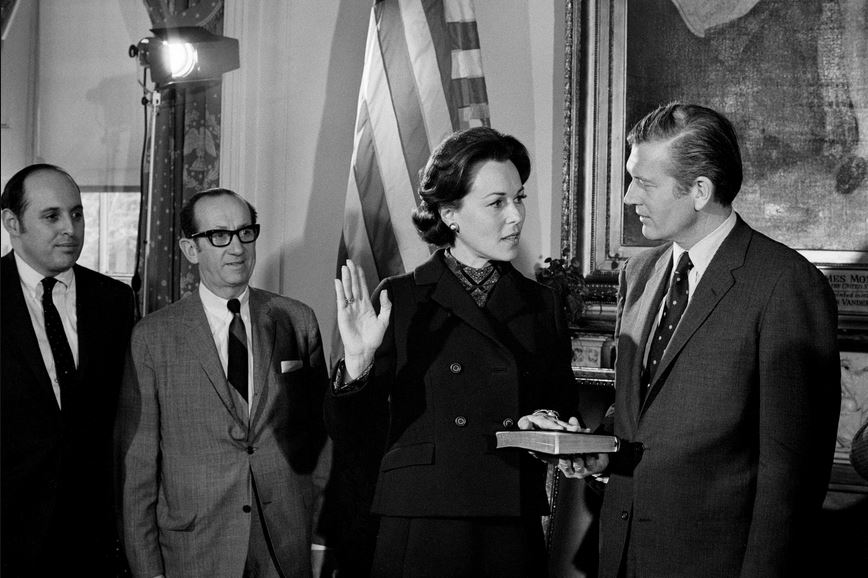Blog Archive
Saluting a Queen of New York: Bess Myerson

Bess Myerson representing New York City at the Miss America pagent in 1945. Photo credit Isaac Brekken for Associated Press. Photo courtesy of the New York Times.
Crowned Miss America in 1945, Bess Myerson first gained fame as a national beauty queen, but in many ways her lasting reign was that of a New Yorker.
Through her many careers; in music, television and politics Myerson was both burnished and tarnished by the limelight. But in everything she did, she was fighting expectations about the roles of women, and the roles of Jews, in American society.
Born in 1924 to a house-painter and a homemaker, Bess came from a relatively modest background. She grew up in the North West Bronx in the Sholem Aleichem Cooperative Houses, which was at the time a creative community of artists. Music was Myerson’s first passion and early talent. She longed, however, for a graduate degree at a prestigious institution such as Julliard and Columbia and for a Steinway piano upon which to play.
Accounts differ as to how Bess was entered in the Miss New York City contest . Myerson claims her sister, Sylvia, entered her picture without Bess’s knowledge. One story goes that Bess and Sylvia attended a baseball game and instead of watching the game, Sylvia realized, everyone was watching Bess. Myerson was crowned Miss New York City. 1945 was the first year that the Miss America Pageant offered a college scholarship and that was incentive enough for Bess to enter the competition.
But in the fall of 1945 a Jewish woman competing in Miss America, had broader implications than a college scholarship. Even as the war drew to a close, a few American blamed the Jews for starting the war. Some American Jews worried that after seeing footage of the Holocaust in Europe, they would be view forever as victims by their fellow Americans. Myerson’s biographer, Susan Dworkin, points out a slightly more comic aspect of being a minority in a beauty pageant “In the Jewish community, she was the most famous pretty girl since Queen Esther.”
Myerson was crowned Miss America in Atlantic City, but the resistance to her religion only increased. As Miss America her duties included touring country clubs, hotel and hospital where she was rejected by members of a discriminatory, white Anglo-Saxon, Protestant community and by occasionally by the parents of veterans.
Disappointed, Myerson returned to New York and began a life-long activism by delivering a lecture entitled “You Can’t be Beautiful and Hate” Anti-Defamation league of B’nai B’rith. Myerson then married and for almost two decades found steady work in a series of game shows, which made much of Myerson’s beauty and poise.

Myerson taking the oath as Mayor Lindsay's Consumer Affairs Commissioner in 1969. Photo taken by Don Hogan Charles for the New York Times. Photo courtesy of the New York Times.
Myerson served as consumer affairs chief under Mayor Lindsay in 1969 and although critics bandied the around the term “window dressing” she brought minor legislation and scrutiny to questionable retailers. Myerson was also a visible member of a group, including Jaqueline Kennedy Onassis which successfully saved Grand Central Station from demolition. President Lyndon Baines Johnson invited her to participate in a conference on crime and violence and President Gerald Ford placed her on a board on workplace issues.
After her divorce from her second husband, savvy campaign organizers gave Myerson a prominent place in Edward Koch’s Mayoral campaign team, helping confront the rumors that Koch was homosexual. She appeared by his side and on his campaign posters. Koch, did of course, win the election.
Later, Myerson leveraged her rising political status to enter a Senate race against Mr. Lindsay but failed to win the election, with many critics saying she was “too glamourous for Senate.”
In a final episode that drowned out some of Myerson’s hard work, and contributions Myerson began an affair with, Carl A. Capasso a married sewer contractor. Subsequent accusations ensued including family court cases, bribery of a State Supreme Court Justice, and investigation of whether Capasso had benefited from a contract through Myerson’s position as a cultural affairs commissioner. All charges against Myerson were eventually dropped but Capasso went to prison for tax evasion. Myerson stepped down from political life but continued to be active in Jewish philanthropy.
Her continued efforts in politics and her support of Jewish philanthropy attested to Myerson’s lifelong challenge, proving that a woman can be beautiful, Jewish, and can make a difference.
–Posted by Julia Berick